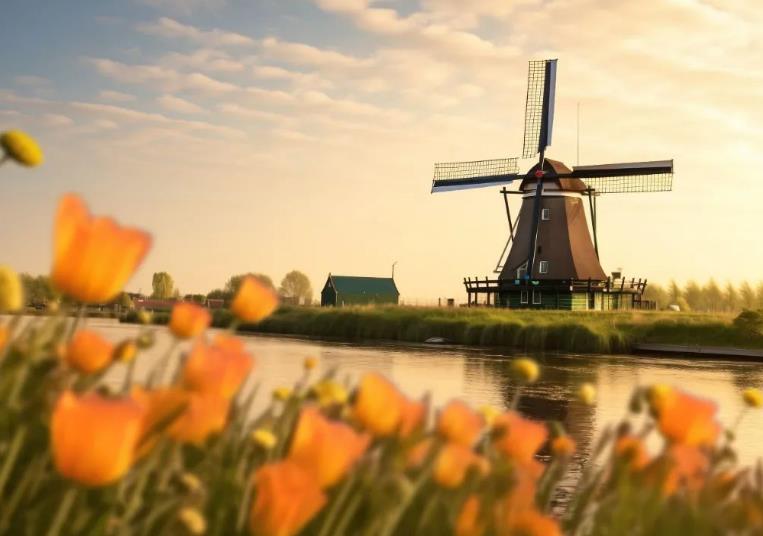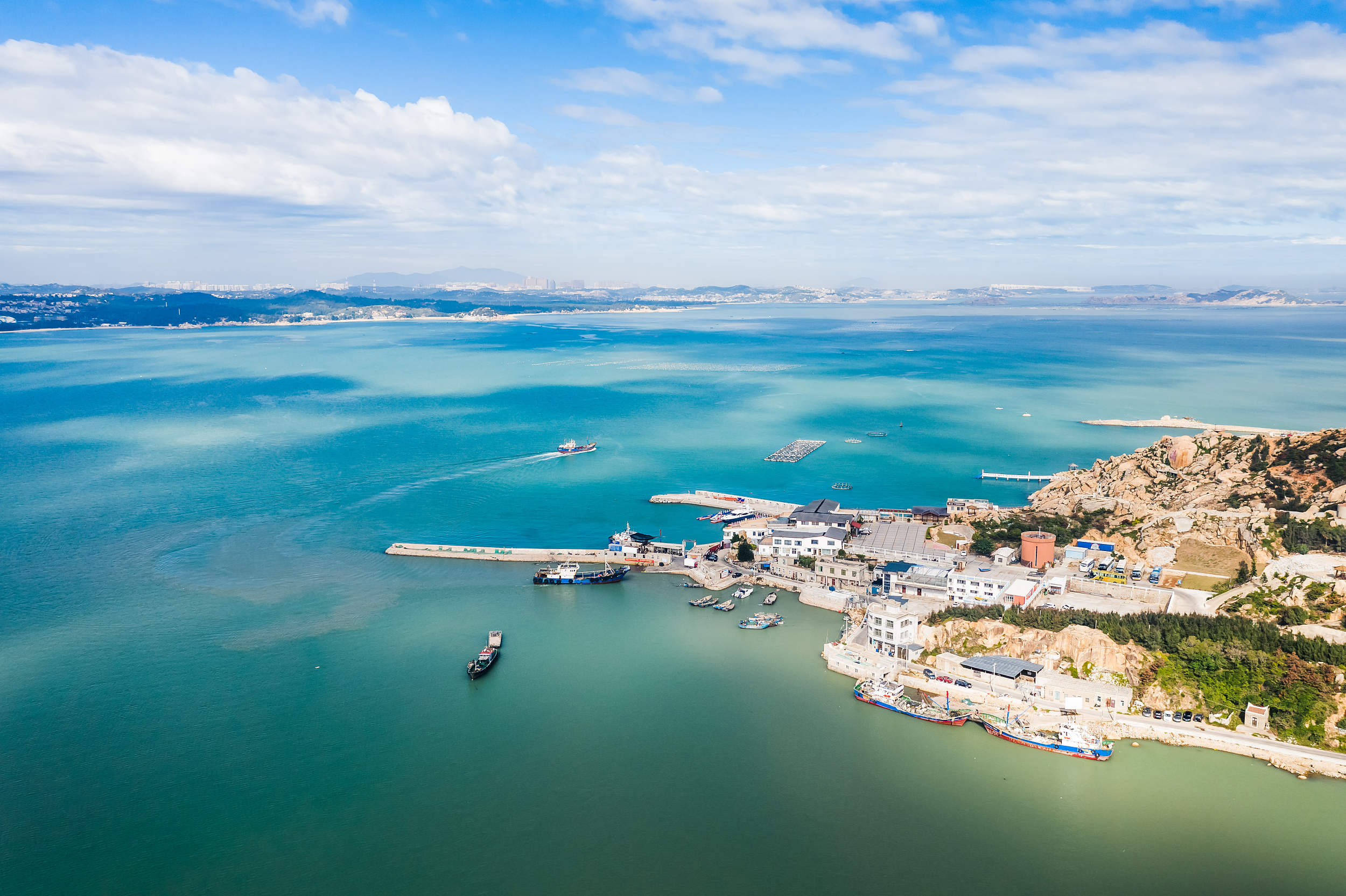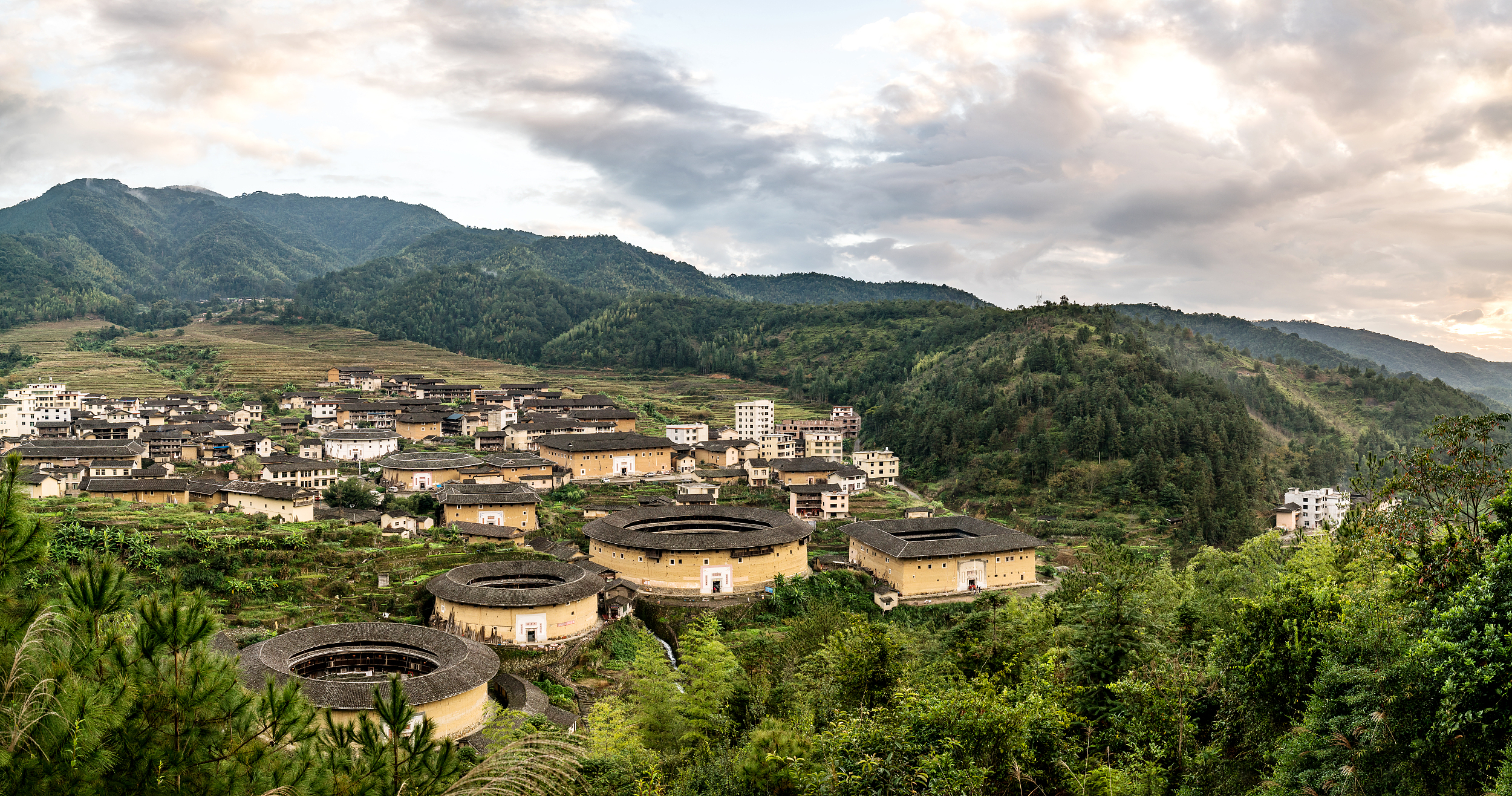https://ph.trip.com/moments/destination-lianjiang-2657/
2025 Lianjiang Travel Guide: Must-see attractions, popular food, hotels, transportation routes (updated in October)
Lianjiang is situated on the coast in the southeast of Fujian province. It has been an important military and transportation hub for generations. The area is surrounded by sea rich in fish and fertile hills that are ideal for rice cultivation. A sizable part of the Chinese diaspora population originates from this region. The most popular attractions include Qingzhi Temple, the Matsu Islands, an ancient shipwreck and an ancient ceramic kiln.
Lianjiang Today's weather
Overcast 19-26℃

Trending in Lianjiang
Popular Attraction in Lianjiang
Qida Village
(52)Xishan Hotsprings
(3)All Trip Moments about Lianjiang
The sea in Fuzhou calling me back 🌊
#chinatravel 🗺️ Quick Visit Outline 1. Drive or taxi to Beijia Village in Lianjiang County. 2. Walk the simple coastal trail out to the rocks and headland. 3. Pause at key photo spots: Snake‑Frog rock, the cliff edge views, and tide pools. 4. Stay until sunset if possible—stunning ocean-to-sky colour transitions. 🌊 Beijiaobi Geological Park (Fujian, Lianjiang County) 📍 Located at the northeastern tip of Huangqi Peninsula in Beijia Village, Taolu Town, Lianjiang #chinatravel #travelchina #china #travel #malaysiatochina #myitinerary #familytravel #chinatrip #fuzhou #福州Joyous Fun5Travelogue of Beihai Tunnel in Beigan: A Wartime Maze Echoing with the Sound of Tides
Beihai Tunnel is one of the most iconic wartime attractions on Beigan Island. Hidden within the mountains between Qinbi and Tanghou, it was originally a military defense project during the Cold War era. Today, it has transformed into a profound historical site for visitors to explore. As I stepped into the tunnel entrance, a damp and cool air greeted me. The dim yellow lights cast mottled shadows on the rocky walls, and the stone steps beneath my feet glistened with traces of seawater. With each step deeper into the tunnel, the surrounding sounds gradually faded, replaced by the echoes of waves and dripping water, as if I had entered a maze frozen in time. The walls of the tunnel still bear the chisel marks from its construction, and every groove seems to echo the hammering sounds of soldiers from the past. The waterway inside the tunnel is even more astonishing. It is a channel wide enough for small boats to navigate, with a deep green surface reflecting the light, intertwining with the rocky walls to create a stark yet magnificent scene. As I gently glided deeper into the tunnel aboard a wooden boat, the sound of the oar slicing through the water was strikingly clear, reverberating through the narrow cavern. The sight before me evoked an image of decades past, when this place might have been an underground naval port, always on high alert, brimming with tension and solemnity. At the tunnel's exit, sunlight spilled onto the sea, with the nearby Qinbi Village in the distance, bringing me back to the present. Yet, the lingering impression of Beihai Tunnel does not fade easily. It stands as a microcosm of Beigan's wartime memories and a marvel shaped by both nature and human effort.日本出發環球旅行者4Battlefield Matsu❤️Nangan Jinsha🏖️Beigan Qinbi
The Matsu Islands, once the front line of war, have quietly turned into a leisure island... Afternoon tea in Qinbi Village, Beigan, and overnight stay at Jinsha Beach, Nangan, elegant and quiet days... Matsu, here I come~ Taste the local flavors of Matsu, the spicy dragon fish head and small yellow croaker are my favorites, and I also love the grilled octopus feet, and I love the handmade fish noodles and the rich aroma of Matsu old wine~STUBON4Matsu Islands
The Matsu Islands are located in the north of the Taiwan Strait, facing the mouth of the Minjiang River, the mouth of the Lianjiang River and the Luoyuan Bay. It mainly consists of Nangan Island, Beigan Island, Gaodeng Island, Liang Island, Dongju Island, Xiju Island, Dongyin Island, Xiyin Island and some nearby small islands, totaling 36 islands! Most tourists go to Nangan and Beigan for travel. Matsu has unique battlefield landscapes, geological landscapes, and eastern Fujian characteristics. There is also a special wonder, blue tears, on the island. Each island has different characteristics and scenery!獨旅琪5Qiguanding|Photos of life taken in Fuzhou are like Rio de Janeiro
I went hiking for the first time in the new year and went to Fuzhou Qiguanding. The whole hike took about 40 minutes. It was a painless way to check in 5🌟attractions. It was also free of charge🎟️. You can look back and see the sea view at every step. There are many photo-taking spots on the top of the mountain, where you can take life-like photos like in Rio de Janeiro. The whole road is made of stone steps and is very easy to walk on. There are also unmanned beverages for sale along the way, so you can just scan the code and take them. There are also drones at the top of the mountain for taking videos and photos. There are several ways to get there: ❤️1. Take the high-speed rail Take the high-speed rail to "Lianjiang Station", take a taxi or carpool, the cost is about 40 yuan/person 💗2. Drive It takes about 1 hour and 30 minutes from downtown Fuzhou, and navigate to "Qigunding". Notice! ️ The best time to take photos is from 1pm to 3pm The light is good and the sun hits your face After 3pm, part of the photos you take will be covered by shadows So if you want to take good photos, you must pay attention to the time Don't miss this niche and cost-effective hiking routeWhimsicalExplorer3No need to go abroad! This small fishing village in Fuzhou is so stunning!
Qida Village is my favorite place on this trip to Fujian. The fishing villages along this line are all very beautiful, with a peaceful and romantic feeling. ⛰️Usually, to take photos of Qida Village, you need to go to the "Qiguanding" on the top of the mountain, which is called "Rio de Janeiro". 🚙Self-driving: Navigate to "Qi Guan Ding", starting from Fuzhou, it takes about 1.5 hours to drive there; 🚅Other transportation: Take the high-speed rail to Lianjiang Station, share a car/charter a car; 👉🏼If you drive up the mountain, you need to walk for about 20-30 minutes to the best photo location after parking. You can also walk all the way up from Qida Village. The climbing time is about 1 hour, and it is free🆓 📸Photography angle: The Internet celebrity stone is located at the top of the mountain. Standing on the stone, open your arms and imitate Rio de Janeiro. The stone itself is relatively safe and not as dangerous as it looks in the photo. There is a wider area below to walk. Be careful when the wind is strong. 🔹There are actually many places to take photos around the Internet celebrity stone, basically from the same angle, suitable for people who are afraid of heights. 🌞Weather: It must be sunny to see the view. It is easy to get foggy on the top of the mountain. You can't see anything when the weather is bad! ⏰Time: There is strong backlight in the morning, and it is more suitable in the afternoon. Try not to go up before sunset. The sunlight will be blocked by the mountain and the village will be dark. It is best to go early; Clothing: Shoes must be non-slip, safety first. 🐟Food and accommodation: You can travel from Fuzhou to Qida Village on the same day. If you need accommodation, you can choose to go to the nearby Dinghai Bay. The food is mainly seafood, including fish noodles, fish balls, fried clam and other authentic seafood snacks._TI***lm70Fuzhou Beijiaobi Geological Park Summer Beach, Enjoy Relaxation and Tranquility.
Fuzhou Lianjiang Beijiaobi Geological Park is the first place in Fuzhou to be touched by the morning sun. In summer, the brighter the sun, the more beautiful the sea. Walking along the wooden boardwalk leading to the ocean, I feel that my midsummer truly begins. On the drive there, colorful buoys appear like rainbows 'planted' in the sea. The dark green seawater crashes against the rocks, creating white splashes. The sea and sky merge in the distance, with green and blue blending perfectly. You can vaguely see the outlines of small islands in the sea, and the rocks embedded in the water vary in shape and depth due to the constant washing of the waves. 🏞️ Indeed, the bravest enjoy the world first; the most beautiful scenery is often hidden behind challenges. Sitting cautiously on the farthest rock, feeling the sea breeze, I seem to experience the loneliness of fishermen drifting in the boundless sea. The rolling waves in my ears remind me of the passage of time, allowing me to quietly enjoy the relaxation and tranquility of the present moment. 🌊Calfsunny67I regret not coming to Lianjiang in Fuzhou earlier, where the per capita cost is less than 200
I really underestimated Lianjiang, the scenery is beautiful and at the same time😭 most of the attractions are free of charge💯 It's very suitable for weekend college student commandos to travel❗ Lianjiang travel route: Qida Village→Qiguanding→Pingliuwei Geological Park (ticket 30)→Beijiaobi Geological Park→Geha Village→Dinghai Bay Beach🏖️ Accommodation🏨 Coming to the seaside, of course, you have to stay in a sea view room✅, so I stayed at the Dinghai Bay Ruolin Hotel, the scenery of the first-line sea view room is what I like😍, the floor-to-ceiling windows in the room are even more impressive! Downstairs is Dinghai Bay Beach, you can take a walk after dinner to digest, and see the beautiful coastline👀 ① Qiguanding Ticket: Free Time: All day There are two routes to climb: 1. Locate Qida Village Qiguanding, this route is all climbing. 2. Locate Baiyun Temple, walk inside, and when you reach the city wall, you are at the mid-mountain position✅ ② Pingliuwei Geological Park Ticket: 30 Time: 9:00-17:00 It is recommended to avoid coming during the strong purple time, 2A scenic spot photography is very photogenic! ③ Beijiaobi Address Park Ticket: Free Come here to walk the plank road leading to the sea, full of atmosphere ④ Geha Village Ticket: Free The Lianjiang shipwreck is right here, if you want to take a close-up photo with the shipwreck🚢, come after 5 o'clock when the tide is low👀 ⑤ Dinghai Bay Beach Ticket: Free One of the three bays of Fuzhou! Coming to Lianjiang, you must check in this 'Little Sanya', the sand is soft and comfortable, and the coastline is also beautiful😍Luna~Price11Fuzhou·Pingtan Island | The Blue Tears Pact of 2024
| The Blue Tears Pact of 2024.📍Pingtan Island, Fuzhou, Fujian Province ■ Blue Tears The Blue Tears phenomenon occurs from March to September each year, but there are two different types of Blue Tears: 💧 March-June: Noctiluca scintillans Blue Tears The peak period for Noctiluca scintillans Blue Tears is April to May each year. They usually appear after 7 PM, and can be seen once it gets dark. These Blue Tears appear in patches and can last for over an hour, with higher levels lasting even longer. 💧 June-September: Sea sparkle Blue Tears The best time to observe sea sparkle Blue Tears is from July to August each year. They generally appear after 9 PM, and most of the time, they can only be seen by stepping on the sand at the beach. Sea sparkle Blue Tears are distributed in spots, and high-level occurrences are rare, so they are usually of a lower level. ■ Qiguan Top 📍Address: Qiguan Top, Qida Village, Fuzhou City 🍉Food recommendations: Fish noodles, fish balls, oyster omelette, various seafood The view at Qiguan Top is absolutely stunning! It's like being in Rio de Janeiro, with breathtaking scenery~ From the top of the mountain, you can see the endless blue sea and the fishing village below Here are some tips for visiting: 1. Choose a day with good weather to visit. We almost missed it due to bad weather, so remember to protect yourself from the sun! No admission fee required~ 2. Taking a taxi to Qiguan Top means you won't have to climb many steps to reach the top. It's about a 15~20 minute walk~ 3. You can also take a ride with a scooter driver for 10 yuan per person to the top of the mountain~ 4. For those who want to exercise, you can climb 1800 steps to enjoy the view~ 5. There are water sellers along the trail, and you can purchase by scanning a QR code~ 6. The better photo spots are on large rocks, but those who are afraid of heights should be cautious and pay attention to safety! There are also places for drone photography, but a smartphone is sufficient~ 🏚Accommodation: Dinghai Bay Ruolin Hotel, a star-rated hotel, ensures hygiene, safety, and service. It's a 20-minute drive from Qida Village, with the beach right downstairs. The rooms have floor-to-ceiling windows facing the sea, so you can wake up to the sunrise. The travel atmosphere is greatly enhanced. The hotel has a restaurant that combines Fujian and Cantonese cuisine, which is quite special and tastes good. In conclusion, coming here is so worth it! Whether you want to take photos, enjoy the scenery, have fun by the sea, or simply relax, you can find your own way here~ Families! Bring your friends and come check in hereALLYSON MURPHY15Matsu Tour
: : : : : : : : : : : : : : :黃貴8😎It turns out that there is such a cool place in Taiwan|Feeding Deer in Daqiu, Beigan🦌
Around 1980, Yuanshan Zoo donated five Formosan sika deer to the Lienchiang County Government. After careful breeding, they were released into the wild on Daqiu Island. Over 40 years later, the deer have adapted and reproduced. You can see the deer on the road🦌 #sikadeer #Daqiu Island #Matsu #Taiwanese sika deer #Taiwan local tour Location: Daegu Travel time: September Boat ticket: Beigan Qiaozi Pier - Daqiu 🚢 round trip $300/person The flight time is about five minutesOkjamami18Beautiful view of Tateyama Kurobe Snow Wall
Tateyama Kurobe just opened on April 15, and everyone couldn't wait to see the beauty of the snow wall. In fact, Tateyama Kurobe is made up of several mountain ranges. This time we took 6 types of transportation, including the mountain tram, cable car, cable car, bus, etc., from Tateyama to the Kurobe Reservoir and finally got off at Ogizawa Station. The altitude climbed all the way up from 675 meters. It was really interesting to take the mountain tram at almost 45 degrees. The scenery along the way also began to slowly change from green to a silver-white world. Every time we arrived at a station, we kept taking pictures and then confirmed the time to get to the next station. Tateyama Kurobe controls the number of people and time to avoid too many people at the same station, and make the overall sightseeing process smoother. Overall, it is a very comfortable experience. You must also go to the observation deck of Daikanfeng, it is so beautiful and spectacular! When you come to Kurobe Dam, you must also take a picture of the arch-shaped dam. You can climb up to the 244-step observation deck to take beautiful photos of the entire dam. From 8 am to 5 pm, you can enjoy the beautiful scenery throughout the entire journey. It is really worth the trip!Mirrenda3Qinbi Village in Beigan
There are two islands in Matsu, Nangan Island and Beigan Island. This is the most famous attraction in Nangan Island. Be careful when riding a bike because the roads in Matsu are very steep. There is a very steep slope right in front of Qinbi Village. There is a Turtle Island right opposite the village. It is very beautiful when viewed from the village. Because of the unique buildings, the houses here have been converted into B&Bs or cafes, so that foreign tourists can experience the style of living here #Good place for parents and children #Local travel #New Year啾啾啾啾53Nangan Beihai Tunnel
This is the tunnel where boats were moored during wars. Walking around here, you can feel that it is very cool inside the tunnel. Because it is in a tic-tac-toe shape, it is one-way. The opening hours are also uncertain due to the tides. You can take a boat or a canoe. It is hard to imagine that this was dug out by humans. There are many blue tears in the water. Every time the blue tears season comes, there will be many people here to see it. If you come to Nangan, you must come here to see it.屁桃26Qinbi Village
Qinbi Village is located on Beigan Island in Matsu. Some people say that it is like a small group tribe. All the houses are built with stones. Each one has its own characteristics. Some residents have opened homestays or cafes, where tourists can come here to taste some food. The interior of the one I chose is very warm, and you can also sit outdoors and drink coffee while looking at the island outside. It is really comfortable #QinbiVillage萱萱愛旅遊39A must-see attraction in Nangan, Matsu. It is also the spiritual pillar of the Mazu people.
Matsu Port, located in Nangan, Matsu, is referred to as Matsu Port for short. There is the Mazu Cultural Park and the Giant Statue of Mazu. The route planning is simple and easy to climb. It is spectacular and beautiful when the weather is good. It is worth recommending! #hotsummergoodplaces #overseastravel #localtravel #familytravelWanderIust41Nangan Mazu Statue
There is a very large Mazu statue in Nangan. You can see Mazu as soon as you go to the island. Mazu blesses the entire Nangan Township. The locals revere her very much. You can see many Mazu temples on the road, so a very large one was built. Mazu came to bless them #马zu萱萱愛旅遊23North Sea Tunnel
Beihai Tunnel is a famous tunnel in Nangan. You can row a boat in the tunnel to appreciate the former boat parking area. You can choose to canoe yourself or take a boat. If you choose to take a boat, there will be a guide to explain to you. The staff are all people who used to look after the boats here, so they know the stories in the tunnels very well, and can also tell you where the best places to take pictures are. I highly recommend everyone to come and play #北海坑道萱萱愛旅遊39Qinbi Village, Matsu
The whole village is like a small maze. The houses are all made of stone, which is quite consistent. However, there are not many interesting shops. I think the night view is okay. It is better to come here to see the buildings and scenery. Jiufen is more recommended.COOLNAN8Can Vu Restaurant in Can Bi Village
A famous restaurant in Qinbi Village, Matsu. You can enjoy the beautiful scenery while dining. It is very romantic and the food is delicious. The only drawback is that this place does not face due west, so you can't see the sunset, which is a bit regrettable.COOLNAN11[Mazu‧Attractions] The world's only Mazu sedan prayer tunnel
#全家出游 Walk out from the second-level platform of the ship-shaped statue of Matsu, You can see a blessing tunnel~~~ It is said that in order to find a place to place the Mazu sedan chair in the park, After asking for permission by throwing a cup, Mazu designated the place to put the sedan chair. When the workers were digging again, they accidentally discovered a war tunnel underneath. It is located just below the giant statue of Mazu. There is just enough space above the tunnel entrance to accommodate the Mazu sedan chair. The size is exactly right. It was simply built for a mikoshi. #Outer Island Travel#Matsu Travel#Parent-Child Travel#Nangan Attractions #prayertunnel This prayer tunnel is the only one in the world where Mazu sedan chairs are used for prayers. To enter the tunnel, you must lower your head like you are crawling under a sedan chair. If you come out from the other end of the tunnel, you will be blessed by Mazu!!! There are also some photos of festivals and activities placed next to the shrine at the tunnel entrance. When you enter the blessing tunnel, don't rush through it. Why not slow down and stop to appreciate it? Get to know the local religious culture! After entering the Qifu tunnel entrance and turning a corner, you will see a brightly lit walkway~~ At the end of the aisle, you can choose to turn right or left. Turn right and you will reach the Menqianshan exit! There is also a trail connecting the mountain in front of the gate. After entering the tunnel entrance, choose to go left and you will reach the south exit. The south exit is connected to the Haihuan Trail, facing Matsu Harbor. The floor of the tunnel is decorated with many famous fish and mussel patterns. The main lighting colors you see when walking forward and backward in the tunnel are different~~ One is yellow light, the other is white light, be careful!! # Outlying Islands Destinations # Fun Places for Families袁小米47#IslandHol
#IslandHoliday 【 Mazu】 Taiwan's Matsu Islands are beautiful Pleasant weather It is a place worth traveling The sunset in Qinbi Village is even more beautiful Seafood mussels So delicious that even kids order it for every meal The season is wrong, otherwise there are still beautiful blue tears...Angela Huang22Fujian Tra
Fujian Travel | There are rogues in the mountains, hidden in the world, hh / in the one-and-a-half-hour drive from Fuzhou, there is a Du Fu ancient village, there is a three-year-old was first built in the end of the Tang Dynasty, is Lianjiang The first person in the county, the official residence of the rites Shang Zhang Zhang Ying. During the Ming Dynasty, the ancient scorpion was destroyed by fire. During the Jiajing period, the Zheng clan who moved here was rebuilt on the original site and has been inherited for more than 20 generations. This is the largest and most preserved ancient dwelling community discovered by Lianjiang. After reborn, the resort hotel is 3,000 square meters. In addition to the hotel, there are also small market, school, art museum, children's play area and so on. The Langxiang Art Museum has a high popularity and internationally renowned works of art abound. It is the base of sketching and creation of Suzhou National Painting Institute. Xiamen University has also established a rural anthropology studio here. The landscape and social functions will be harmonious. The Langxiang Art Museum is also the first stop of the 16th Venice Biennale China Pavilion tour, and is still open to the public. self-driving: navigation and positioning [Fujian, Dujiangyan, Danyang Town, Lianjiang County, Fuzhou City], the entrance to Guihu, the high speed, Danyang Expressway, then 10 minutes to the 104 National RoadAbby..5Fuzhou Qin
Fuzhou Qingzhi Mountain, plum blossomsBlue_Wet.3There is a
There is a cloud tea garden in Lianjiang Changlong Town. When it is spring and summer, the clouds are gone, it is very romantic.Blue_Wet.4Many place
Many places in and around the world are dedicated to the temples of Mazu, also known as the Tianhou Palace. Fuzhou was once an important part of the Silk Road in the sea. Since ancient times, there have been customs of the Mazu, and it is not uncommon to have many Mazu Temples. There is a Luozhou Tianhou Palace in Luozhou Ancient Town of Cangshan District, Fuzhou City. This Tianhou Palace has undergone many repairs to preserve the appearance of today.Sharer.4Stunning Seaside Shimen Check-in Spots
The 20-minute park effect is truly amazing! Sharing some favorite outdoor spots with everyone~ There are also excellent platforms for watching the sunrise and sunset, enjoying beautiful scenery while relaxing your mind. A great destination for travel! 1️⃣ Beijiaobi Geological Park 📍 Address: Seaside at Matoushan, Jiaohou Road, Beijiao Village. 2️⃣ Yantai Mountain Park 📍 Address: No. 14 Meiwu Road. 3️⃣ Jingtai Mountain Park 📍 Address: No. 30 Shuqian Road. 4️⃣ Mao'er Mountain Forest Park ⏰ Opening Hours: Monday to Sunday, all day 📍 Address: Yanlong Road 5️⃣ Tangdao Bay Park ⏰ Opening Hours: Monday to Sunday, all day 📍 Address: South section of Binhai Avenue, Lijiang West Road (near South Gate of Petroleum University) 6️⃣ Fushan Forest Park ⏰ Opening Hours: Monday to Sunday, all day 📍 Address: Yinchuan West Road 7️⃣ Yan'er Island Mountain Park 📍 Address: Macau Road. 8️⃣ Daqi Mountain National Forest Park ⏰ Opening Hours: Monday to Sunday 08:30-16:00 📍 Address: Daqi Mountain Road, Chengnan Street, Daqi Mountain The parks I have visited, spontaneous outdoor trips during National Day, sunrise and sunset viewing spots, 99 kinds of refreshing outdoor activities, my outdoor treasure spots, my niche travel guide. Live reports from frontline National Day attractions, collecting sunset check-in locations.Isabella~Thompson7Fujian hides a "Rio de Janeiro on the sea"! Qida Village Guide: 1800 Steps to See Mountains and Sea
Along the coastline of Lianjiang, Fuzhou, lies a thousand-year-old fishing village—Qida Village. Here, there are no crowded crowds, but a stunning scene of "mountains and sea embracing each other, fishing rafts woven like fabric." The moment you reach the top of Qiguan Peak, you'll understand why it's called the "Rio de Janeiro of Fujian." This in-depth guide, from transportation to dining and accommodation, will help you unlock every surprise of the fishing village. 1. Transportation Tips: Avoid detours and traffic jams Best option for self-driving From Fuzhou, take the Ring Expressway → Pukou Hub → National Highway 228 (Coastal Corridor), 91 km about 1.5 hours direct. Key navigation tip: don’t search for "Qiguan Peak," directly locate "Baiyun Temple," park at the city wall gate roadblock, then walk 20 minutes to the viewing platform, saving one-third of the mountain road. Be sure to arrive before 6:30 on holidays, or the coastal road is prone to traffic jams. You can also reverse the route by visiting Moon Bay first, then climbing the peak. Guide for those without a car High-speed rail: Fuzhou Station → Lianjiang Station (12 RMB/30 minutes), then take a 10 RMB taxi to Minyun Lianjiang East Bus Station, transfer to the Qida special line (15 RMB/person, 1-hour ride). Important reminder: the last bus departs at 16:00; if missed, you must carpool (30 RMB/person). If lucky, the charter driver will take the secret coastal route, perfect for shooting windmill matrix photos along the way. 2. Must-visit spots: Ultimate experiences from sunrise to starry sky Qiguan Peak: 1800 steps for panoramic mountain and sea views As Qida Village’s "beauty ambassador," it hides the viral "Rio perspective" online. There are two ways to reach the top: the hardcore version climbs 1889 steps (about 1 hour, with self-service supply stations midway), or the lazy version walks the "Little Great Wall" trail from Baiyun Temple (25 minutes direct). Photo tips: Use a 24mm wide-angle lens at the top where the five-star red flag is planted to capture the clash of fishing village and sea sky; use a telephoto lens at the third viewing platform to compress the windmill group and fishing boats; the phone’s 0.5x mode makes the shot even more stunning. Best times: 5:30-8:30 for blue hour shots, after 17:00 for sunset gold, where windmills and evening glow create breathtaking scenes. Offshore fishing rafts: immersive one-day fisherman experience The best times to board the fishing rafts are 9:00 or 15:00. Look for the waterside restaurant "Tianshu Seafood Building," where you can order freshly caught bitter conch, hand scallops, octopus—850 RMB gets you 17 dishes to eat until you can’t move. For something special, book the 150 RMB/night light lure night tour to see octopuses clinging to searchlights in a magical scene. On the way, visit Tongxin Village’s Abalone Museum (free), and buy 35 RMB packs of ready-to-eat abalone as souvenirs. Ancient city walls and Baiyun Temple: hiding the village’s old stories Qida Village’s Ming Dynasty ancient city walls are full of life. Touch the Ming Dynasty brick wall at Guangyi Gate and walk clockwise three times; villagers say it boosts career luck. Every Saturday night there’s a lighting ceremony, and wearing Hanfu to shoot blue hour photos creates a great atmosphere. Baiyun Temple is not only for blessings; on the east side of the main hall is the "Woyun Stone" with an interesting story—taking a 20-minute nap there is said to let you dream of your fortune for the next three months. Along the way, you can also encounter wild azalea flower seas. Moon Bay: joyful time for tide hunting and treasure digging During the big tides on the first and fifteenth days of the lunar calendar, the reef area here hides general’s hats and spicy conchs. Bring a small shovel to enjoy tide hunting fun. Using an ND1000 neutral density filter for long exposure shots of the sea surface can create a silky texture. Flying a drone to 200 meters height captures the full panorama of "Crescent Bay." 3. Culinary feast: local secret seafood map Must-eat list: full for about 50 RMB per person - Apang Fish Ball Shop: must order the fish ball and swallow dumpling double soup; handmade fish balls are bouncy and juicy, only 15 RMB/bowl to satisfy cravings. - Tianshu Seafood Building: three ways to eat abalone (steamed + sashimi + rice), great value; 5-head abalone only 60 RMB, fish balls without filling have over 90% fish paste. - Village Entrance Night Stalls: traditional oyster omelet 20 RMB/serving, iron plate charred aroma with sweet and spicy sauce, the true flavor of the fishing village. - Xinghai Restaurant: 38 RMB kelp shoots stewed with pork belly, fresh and sweet to cut grease; local sword shrimp boiled with garlic soy sauce, incredibly fresh. Avoid pitfalls and hidden menu ❌ Avoid: "freshly opened oysters" in scenic spots are often from other places, 15 RMB each is low value; roadside "sea anemone pancakes" have a strong fishy smell and may upset your stomach. ✅ Hidden gems: Rio homestay’s salt and pepper water electric fish with sweet potato stew is a killer dish; during the blue eye tears season from April to June, Housha homestay offers a special "Blue Eye Tears Cocktail," with glowing algae in the cup recreating the sea spectacle. 4. Accommodation choices: sea view from the window or sleeping with the waves Top choice for sea view lovers - Dinghaiwan Ruolin Hotel: 240° floor-to-ceiling windows + private beach, 5-minute walk to tide hunting area, butler offers sunrise wake-up service, about 300 RMB/person per night. - Housha·Azure Coast Homestay: cliffside infinity pool + starry sky tents, free tide hunting tools, and night squid catching appointments available, about 250 RMB/person per night. Fishing village style Tinghai Cottage is renovated from a century-old bluestone house; you can hear the tide lying in bed. Grandma’s handmade seafood porridge can be refilled for free; for about 120 RMB/person, you can experience authentic fishing village life. For nature lovers, camping at Qiguan Peak is available for 50 RMB/person, including a 4 a.m. sunrise wake-up service (reservation required). 5. Itinerary planning: 1-day highlights or 3-day immersion 1-day fast-paced version 5:30 Climb Qiguan Peak for sunrise → 8:30 Seafood feast on fishing rafts → 10:00 Ancient city wall photo shoot → 14:00 Tide hunting at Moon Bay → 17:00 Sunset at Chaoyang Pavilion. 3-day deep version D1: Qiguan Peak sunrise → Baiyun Temple dream blessing → Fishing raft lunch → Explore Ming and Qing stone houses → Overnight in stone house listening to tides; D2: Tide hunting at Moon Bay → Speedboat exploration of Xiluo Island → Experience Sea God customs (municipal intangible cultural heritage) → Longshan Li Night Market oyster feast; D3: Pingliuwei Geological Park cliff walkway → Ancient Stone Village lawn camping → Return trip with fish noodles/abalone dry goods shopping. 6. Pitfall avoidance and tips: advice from veteran fishermen 1. Dress code: no flip-flops! The stone steps and reef areas hide oyster shells; water shoes are a must; 2. Tidal secrets: search "Lianjiang Tide Table" on WeChat; big tides double your tide hunting harvest, and on the fifteenth lunar day, you might dig up palm-sized blue crabs; 3. Photography timing: strong light from 11:00 to 14:00 swallows mountain and sea layers, best to hide in the homestay eating seafood then; 4. Anti-scam reminder: refuse guided "abalone picking" inducements; buy seafood with the "Ankai Township" origin label. Here, no need to squeeze into crowded spots—just sit on the fishing raft watching the waves roll, listen to grandma’s fishing village stories, and enjoy a bowl of seafood porridge with the sunset. The romance of Qida Village has always been this simple yet passionate.gwendolyn_juniperhale

Popular Lianjiang topics

2025 Recommended Attraction in Lianjiang (Updated October)
261 posts

2025 Recommended Guides in Lianjiang (Updated October)
211 posts

2025 Recommended Comprehensive guides in Lianjiang (Updated October)
76 posts

Destinations related to Lianjiang

2025 Fuzhou Travel Guide: Must-see attractions, popular food, hotels, transportation routes (updated in October)
1853 posts

2025 Pingtan Travel Guide: Must-see attractions, popular food, hotels, transportation routes (updated in October)
1365 posts

2025 Longyan Travel Guide: Must-see attractions, popular food, hotels, transportation routes (updated in October)
278 posts
- 1
- 2
- 3
- 4
- 10
Post
More recommendations
Popular Trip Moments
Fujian hides a "Rio de Janeiro on the sea"! Qida Village Guide: 1800 Steps to See Mountains and Sea | Fuzhou is the ultimate place for family fun! Spend a whole day going wild at O’Le Bao, then relax perfectly at the Golden Step Hotel | Matsu Beigan | War and Peace Memorial Museum: Historical memories from the Cold War front transformed into inspiration for safeguarding peace | Matsu Dongyin|Zhonglu Story House: Old houses carry memories of the fishing village, showcasing the island's history and people | [Mazulan's Tears] Nangan Beihai Tunnel: Rowing boats at night, lighting up the dreamy blue light secret world | Underwater Paradise must-visit, a favorite for families with kids: Dreamy Oceanarium Guide | Fujian’s Rio de Janeiro! Ultimate Guide to the Stunning Mountain and Sea Views at Qiguan Peak, Free Photo Spots for Life’s Best Shots | Tateyama Kurobe: A Must-Visit Autumn Spectacle | Silent Landscapes: Lianjiang Xishan Resort, Fuzhou | Colorful and Serene—Lianjiang Gui'an New World Resort | Ningde 3 Days 2 Nights|A Seriously Underrated Hidden Mountain and Sea Paradise! Few People, Stunning Scenery That Takes Your Breath Away | Two-day and one-night outlying island trip: Matsu and Nangan! | The Hidden Blue of Fuzhou That Heals All Fatigue | Matsu Beigan One-Day Tour: A Fusion of Coastal Beauty and Wartime Heritage | The Primal Beauty of Mountain and Sea Symphony‖The Blue Romance of a Millennium-old Fishing Village~ | Travelogue of Beihai Tunnel in Beigan: A Wartime Maze Echoing with the Sound of Tides | Cozy room | First experience at Jingjiang Hotel | Gu'an and Pintang Island, Fujian province. | Fuzhou Trip Report: July-August Not Recommended (Too Hot!) | enchanting lianjiang pingliuwei garden | lianjiang beijiaobi | Around Fuzhou|Step into the real-life "Wizard of Oz"! 25℃ Waterfall Secret Spot | Lianjiang, Fujian's Hidden Ceiling of Oceanic Aesthetics! | Help! Fuzhou's Hidden "Seaside Utopia" | Fairy Water Castle Family Travel Guide: A Cool Summer Escape to a Joyful Water World | Berry Crab Valley Scenic Area | Battlefield Matsu❤️Nangan Jinsha🏖️Beigan Qinbi | Fuzhou Gui'an Water World: The Ultimate Summer Water Fun Destination!
Recommended Attractions at Popular Destinations
Popular Attractions in Sydney | Popular Attractions in Dubai | Popular Attractions in Paris | Popular Attractions in Shanghai | Popular Attractions in Phuket | Popular Attractions in New York | Popular Attractions in Tokyo | Popular Attractions in Bali | Popular Attractions in Melbourne | Popular Attractions in West Lake | Popular Attractions in Iguazu National Park(Argentina) | Popular Attractions in London | Popular Attractions in Rome | Popular Attractions in Kuala Lumpur | Popular Attractions in Chefchaouene | Popular Attractions in Singapore | Popular Attractions in Kyoto | Popular Attractions in Los Angeles | Popular Attractions in Zanzibar Island | Popular Attractions in Las Vegas | Popular Attractions in Osaka | Popular Attractions in Walt Disney World Resort | Popular Attractions in Beijing | Popular Attractions in Bangkok | Popular Attractions in Barcelona | Popular Attractions in Chengdu | Popular Attractions in Florence | Popular Attractions in Madrid | Popular Attractions in Jungfrau Region | Popular Attractions in Istanbul
Popular Restaurants in Lianjiang
必胜客(连江店) | McDonald's (lianjiangwanjia) | 奇达渔家乐酒楼 | 银座烧肉·日本料理(连江万星广场店) | 立山黑部 | 君豪大饭店·源铁板餐厅 | 福州望江园 | 红运火锅(连江店) | 海天大酒楼 | 馥约花艺咖啡 | Taiwanxin Restaurant | 趣玩户外烧烤海边BBQ店(赶海一号店) | Fuzhougui'anshijijinyuandafandian-yanhuiting | 连江福鱼荟·海上度假民宿·海洋之星餐厅 | 德克士(连江店) | 韩兴鱼丸店 | 玛格利塔现烤披萨·意面(连江贵安永辉店) | 山里饭店(贵安店) | 麦当劳(时代广场店) | Lianjiangguohui Restaurant (chacanting) | 华莱士·全鸡汉堡(连江贵安店) | QING KOU QING SHANG MIAN LIAN JIANG DIAN | 必胜客(贵安新天地店) | 华莱士·全鸡汉堡(丹凤店) | 华莱士·全鸡汉堡(文山店) | Hualaishi (aojiang) | 正新鸡排·炸鸡烧烤(瑞金店) | 马鸣渔粉(万家店) | 连江溪园三落厝度假酒店·杜棠宴餐厅 | Magelita (wenshanbeilu)
Popular Ranked Lists
Top 10 Trending Attractions in Taiyuan | Popular Trending Attractions in London | Popular Premium Hotels in Newton Abbot | Popular Premium Hotels in Sumur Bandung | Popular Trending Attractions in Hexigten Banner | Top 20 Must-Visit Restaurants in Shantou | Popular Premium Hotels in Shozu District | Top 20 Must-Visit Restaurants in Venice | Top 20 Must-Visit Restaurants in Tengchong | Popular Premium Hotels in Ahmednagar | Popular Premium Hotels Near Saint John | Top 10 Trending Attractions in Dubai | Top 20 Trending Attractions in Nanjing | Top 20 Luxury Hotels near Indian River County | Top 20 Must-Visit Restaurants in Changchun | Top 20 Trending Attractions in Guangzhou | Popular Luxury Hotels Near North Myrtle Beach | Top 20 Must-Visit Restaurants in Shangri-La | Popular Trending Attractions in Kaifeng | Top 20 Luxury Hotels near Osceola County | Top 20 Must-Visit Restaurants in Lingshui | Top 20 Must-Visit Restaurants in Zhangzhou | Popular Premium Hotels in Courbevoie | Popular Trending Attractions in Xiangyang | Top 10 Trending Attractions in Wuxi | Popular Trending Attractions in Ejin Banner | Popular Premium Hotels in Shodoshima | Top 20 Must-Visit Restaurants in Nagoya | Popular Trending Attractions in Ergun | Top 20 Must-Visit Restaurants in Amsterdam
About
Payment methods
Our partners
Copyright © 2025 Trip.com Travel Singapore Pte. Ltd. All rights reserved
Site Operator: Trip.com Travel Singapore Pte. Ltd.
Site Operator: Trip.com Travel Singapore Pte. Ltd.